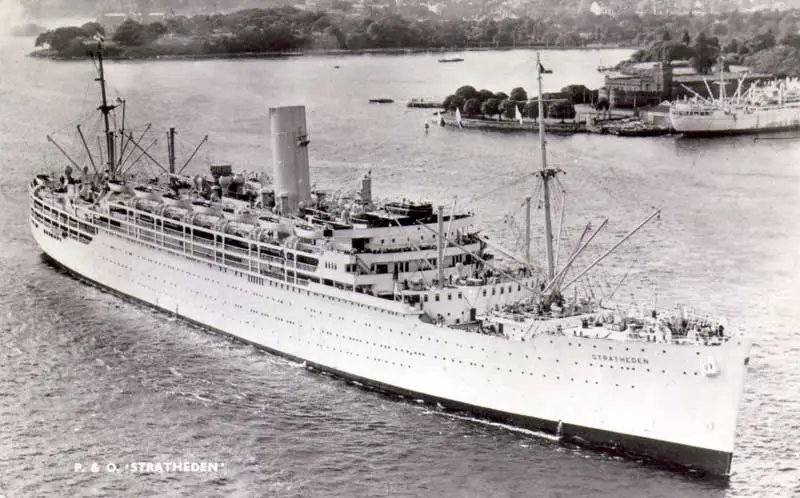
After the Great war of 1914-18, Australia experienced what up until then had been its biggest surge in immigration from Europe. Australia was seen as the great land of opportunity and became one of the top places to migrate to, particularly from Britain. The increase in migration to Australia led Britain’s leading shipping line to the Far East, the Peninsular and Oriental Steam Navigation Company (P&O;), to invest in a fleet of new ships of around 20,000 tonnes each to handle the business coming their way. Their introduction was a major feature of Lord Inchcape’s Chairmanship between 1915 to 1932. Originally, there was no fixed number of new ships planned, except the two near-identical ones that would be produced first. Others to the same design would then be ordered as and when custom demanded they be added to the fleet. The two new vessels, designed specifically for the England – Australia run, were the Strathnaver and Strathaird. The decision to build them was made in 1927. It was a 90 year old tradition at P&O; to name some of its vessels after places in Scotland with the prefix Strath, and the tradition was continued with these two new liners. Work commenced on Strathnaver early in 1930 at the Barrow-in-Furness yards of Vickers-Armstrongs, where all the ‘Strath’ sisters were built. Strathaird followed a few months later. By February 1932, both ships had been launched and were in service.
Between the Wars, the Australian trade replaced the Indian services as the most important for P&O.; Australian passengers encouraged the provision of games decks. Oil fuel replaced coal and the ‘Strath’ liners of the 1930s reintroduced white livery previously only used on two ships, in place of the conservative black hull and funnels and stone-coloured superstructure that had been the Company’s image for so long. Second Class gave way to Tourist, and after the great Depression, when salaries were cut by 10% and no dividend was declared for four years, P&O;’s nominal Centenary in 1937 was celebrated with enthusiasm. An advertisement placed by Mackinon Mackenzie & Co. in Colombo in the mid 1930’s promoting its newest ships the Strathaird, Strathnaver and the slightly older Viceroy of India gives an idea of how the ships and the service they offered were promoted. The Viceroy of India, though painted black and built a few years earlier (1929), had introduced a new level of luxury and speed to the service. It was the first P&O; ship to have an indoor swimming pool.
All three ships were turbo-electric, steam turbines powering giant electric motors. The ‘Strath’ liners were all white and surpassed even the Viceroy of India in design, popularity and service. They introduced white colours as a permanent feature of the P&O; ships and at the time these two liners were nicknamed the ‘White Sisters’. Speed and power was further suggested by having three funnels, although only the middle one was real. They also had indoor swimming pools and the same level of luxury and speed that had made the Viceroy of India such a success on the England to Bombay run.
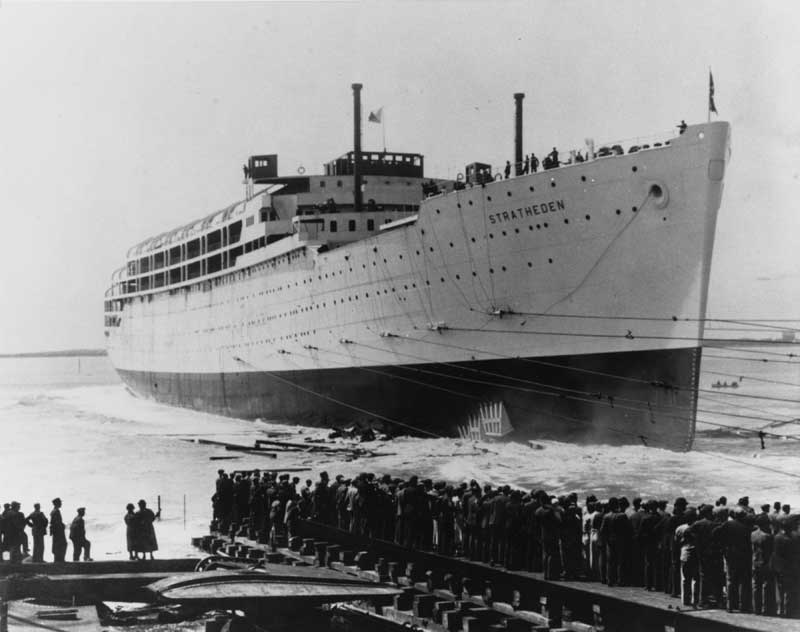
The launch of RMS Stratheden, Barrow-In-Furness, Cumbria, England, 10 June 1937
In spite of the fact that the effects of Great Depression were beginning to take effect across the world, within a year of the Strathaird being brought into service, a decision was made to build another two ‘White Sisters’ to handle the increased trade the first two ships had generated. These would be similar to the first two, but slightly larger and incorporating updates and modifications to rectify minor problems which had arisen. The propelling machinery was different. P & O had used turbo-electric propulsion for the earlier two ‘Straths’ and also for the Viceroy of India. Although these installations had been satisfactory, there had apparently been no significant savings in running costs. The capital costs of turbo-electric equipment were higher than geared turbines, and the machinery had to be built by an electrical firm (British Thomas-Houston). The ship builders themselves could construct the latter type. Consequently, this machinery was chosen for the Strathmore and the following two ‘Straths’. Six water tube boilers, four large and two small provided steam. The Strathmore, Strathallan and Stratheden were slightly larger that the first two ships, with a length of being 202 m and breadth of 25 m. They each weighed approximately a tonne more than the first two Straths also.
Strathmore went into service towards the end of 1935, Stratheden followed two years later, by which time P&O; had already placed an order for its fifth and final ‘Strath’, the ill-fated Strathallan which would be torpedoed and sunk during World War II.
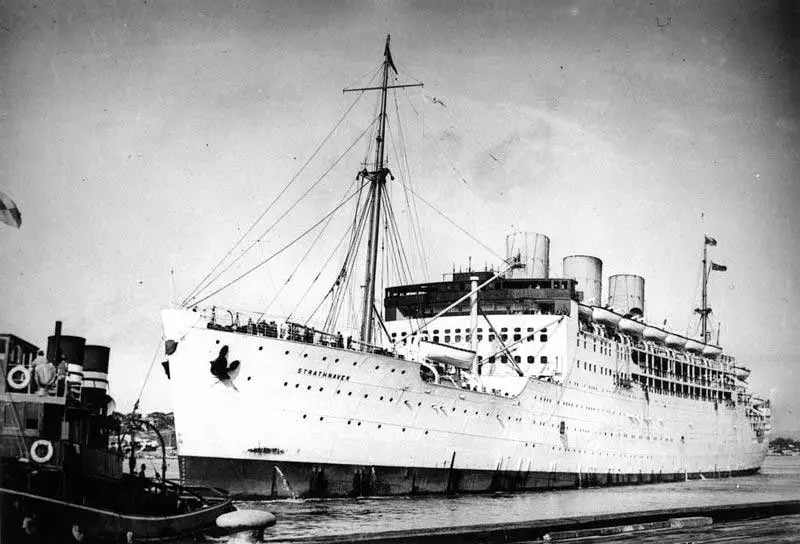
Strathnaver was the first of the five ‘Straths’ to be built. The main external difference between the first two ‘Straths’ and the other three is that they originally had three funnels. The propelling machinery was also different in them, P & O having used turbo-electric propulsion for the earlier two ‘Straths’ and for the Viceroy of India. Strathnaver and Strathaird were identical in length, which was slightly less than the following Straths. Strathnaver was reconditioned in 1946-7 and had two of her funnels removed. She resumed the UK – Australia run in January 1948. In 1954 she was refitted and converted from being a double class ship to single class. Strathnaver was the first passenger ship through the Suez in late 1957 after Egyptian President Nasser had closed it in 1956 in what is remembered as the Suez Crisis.
Strathnaver was named after the area of Strathnaver, a region in the very northwest of Scotland, which at one time covered a large part of north and west Sutherland in Scotland. The name Naver reflects the strong Norse influences, which Sutherland has experienced in the past. The valley of Strathnaver is the richest in that part of the country, a narrow twisting glen down which the black water of the River Naver runs from south to north, from the loch of its name to the Atlantic Ocean. Some of the worst atrocities in the movement of Highland people took place in Strathnaver for it was here in June 1819 that the infamous Strathnaver Clearances began on the Sutherland Estates. Families were given about half-an-hour to remove their belongings before their houses were set ablaze, to make way for sheep.
Specifications
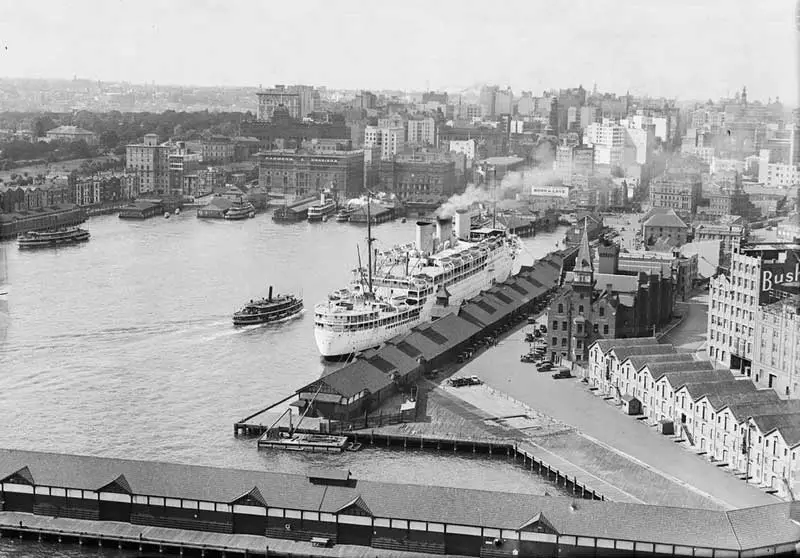
RMS Strathaird at Sydney Cove on her maiden voyage, March 24, 1932
Like Strathnaver, Strathaird began life with three funnels. In December 1932, she became P&O;’s first cruise ship, when the company began experimenting with the scheduling of 5 days cruises from Sydney to Fiji and back in between her UK to Australia trips. In September 1939, Strathaird and Strathnaver were both requisitioned as troop carriers – the sisters were dispatched to familiar waters, heading down-under to commence transporting Australian and New Zealand troops to the Middle East. Strathaird sailed on two convoys before returning to Liverpool to undergo a refit. However, before completion, she was sent to Brest to evacuate 6000 civilians and troops, returning them to Plymouth, after which the refit was completed and she returned to her wartime duties. Having carried some 128,961 persons and covered 387,745 miles, Strathaird was handed back to P&O; at the end of 1946.
Before return to her formerb passenger duties, RMS Strathaird was reconditioned and had two of her funnels removed as did Strathnaver. She resumed the UK – Australia run in Jan.1948. In 1954 she was refitted and converted from being a double class ship to single class and used primarily for the transfer of migrants to Australia from Britain. Strathaird departed Tilbury for Australia for the last time on 28th March 1961, and then departed Sydney on 9th May for what would be the final voyage back to Britain, arriving in Adelaide on 15th May. She left Fremantle and Australia for the last time on 19th May. Somewhere near Port Said, Strathaird passed her replacement, the brand new SS Canberra, on her maiden voyage. Upon her return to Tilbury, she was sold to Hong Kong breakers. She departed Tilbury on 17th June 1961, arriving at the Shun Fung Iron Works in Hong Kong on 24th July and was handed over for demolition. She was the first of the Strath sisters to be broken up.
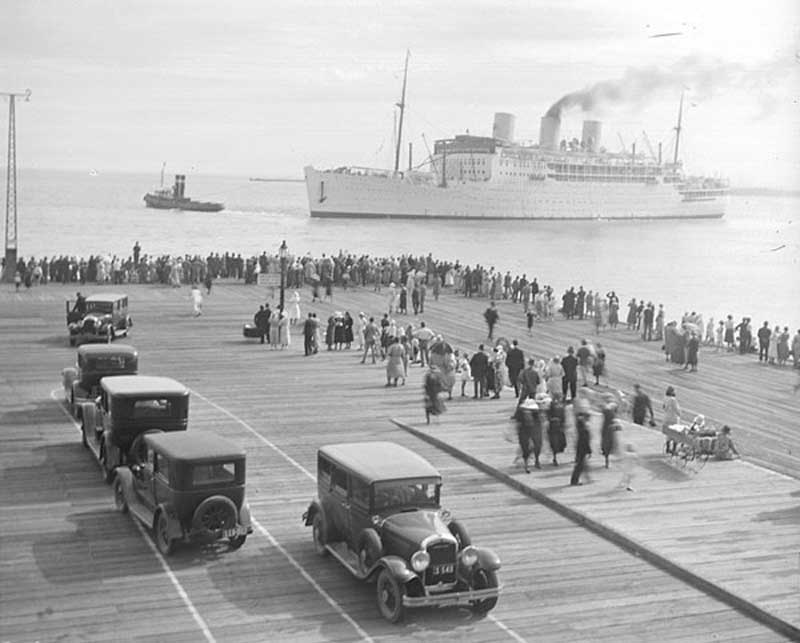
RMS Strathaird arriving at Station Pier, Melbourne. Photo: Museum Victoria
During her lifetime, Strathaird carried more than her fair share of notable people. In March 1948, seventeen Australian cricketers boarded her at Fremantle, bound for England to do battle for the ultimate prize The Ashes. They would never be forgotten in the history of cricket and became known as “The Invincibles”. In April, 1948 these “Touring Australians” captained by Don Bradman and Vice-Captain Lindsay Hassett arrived to a warm welcome at Tilbury, London. This was the first test series since the end of World War 11, in which England and her people had suffered immensely.
Dr Bennett, an authority on Australian marine life and the ecology of the Great Barrier Reef. She joined the staff of the University of Sydney in 1933 after migrating to Australia on the Strathaird on her maiden voyage. Sir Robert Menzies was forty before he visited England for the first time in 1934, 5 years before the commencement of his first term as Australia’s Prime Minister. He went as a member of the Australian delegation attending King George V’s Silver Jubilee, sailing on the Strathaird. A team of 10 swimmers representing Australia at the Olympic Games in London in August 1948 sailed to England on the Strathaird earlier that year. Singer Olivia Newton-John migrated with her parents, her older brother Hugh (he became a doctor) and sister Rona (she became an actress) to Australia. They left London on 16 October 1954 for Melbourne when she was 6, travelling on the Strathaird. The editor of this website, Stephen Yarrow, then 9 years old, migrated to Australia with his family aboard the Strathaird in June 1960.
Specifications
- Strathaird, Australia’s First Cruise Ship
- RMS Strathaird: Feature Story
- Built by Vickers-Armstrong of Barrow – 1935
- Launched: 4th April 1935 by the Duchess of York, the Queen Mother
- Maiden voyage: 26th October 1935.
- Gross Displacement: 23,428 tonnes
- Cruising speed: 20 knots.
- Named after the Strathmore district of Scotland, to the north east of the city of Dundee on the east coast. Strathmore vale, with its cattle farms and steep braes, divides the Grampian Mountains and Sidlaw Hills from the Firth of Tay and the area’s splendid beaches.
- Route operated: London – Australia via Suez Canal.
- Subsequent Names: Marianna Latsis (1963); Henrietta Latsis (1966)
- Ultimate Fate: Broken up at Spezia, Italy, May 1969
- Built by Vickers-Armstrong of Barrow – 1935
- Built by Vickers-Armstrong of Barrow
- Gross Displacement: 23,732 tonnes
- Launched: 10 June 1937
- Maiden voyage: 24 December 1937
- Cruising speed: 20 knots.
- Named after the valley of the River Eden in Fifeshire, Scotland. Of Scotland’s rivers, the Eden is the longest; formed on the borders of Kinross-shire by the confluence of Beattie Burn and Carmore Burn, it pursues a wandering course from 38 km. N.E., partly through the Howe, or Hollow of Fife, and empties into the North Sea.
- Route operated: London – Australia via Suez Canal.
- Subsequent Names: Henrietta Latsis (1963); Marianna Latsis (1966)
- Ultimate Fate: Broken up at Spezia, Italy, May 1969
- Built by Vickers-Armstrong of Barrow
- Launched: 23rd September 1937 by the Countess of Cromer, wife of a P&O; Director
- Maiden voyage: 18 March 1938 Launched: 23rd September 1937 by the Countess of Cromer, wife of a P&O; Director
- Gross Displacement: 23,722 tonnes
- Cruising speed: 20 knots.
- Name: the name Strathallan has been in use by the P&O; shipping company since 1858 when P&O; was appointed carrier of the Royal Mail between England and Australia and the company’s first vessel of that name inaugurated the service. The name recalls the valley of the Scottish River Allan. The valley’s rolling farmlands are part of the countryside surrounding the ancient town of Stirling. Bridge of Allan is an elegant former spa town nestling on the banks of the Allan Water.
- Route operated: London – Australia via Suez Canal.
- Ultimate Fate: Torpedoed and sunk off the coast of Algiers in the Mediterranean Sea by German U-Boat 562, 21st December, 1942, sunk 22nd December, 1942.
- Built: 1949 Vickers-Armstrongs, Barrow-in-Furness, England for P&O.;
- Named after a group of islands in the bay beyond the estuary of China’s Yangtsze River.
- Launched: 28th June 1949
- Maiden voyage: 14th July 1950
- Length: 205 metres
- Beam: 26 metres vGross displacement: 24,261 tonnes
- Propulsion: twin screw, double reduction steam turbine
- Cruising speed: 22 knots
- Accommodation: 217 First Class cabins (474 passengers), 259 Tourist class cabins (541 passengers), 556 crew.
- Major refit in 1959.
- Built: 1949 Vickers-Armstrongs, Barrow-in-Furness, England for P&O.;
- Launched: 5th October 1948
- Maiden voyage: 6th October 1949
- Length: 216 metres
- Beam: 27.6 metres
- Gross displacement: 27,989 tonnes
- Propulsion: twin screw single reduction steam turbine
- Cruising speed: 22 knots
- Accommodation: 760 first class, 410 second class. 631 crew. Reconfigured as all Tourist Class for 1,416 passengers in 1963.
- Built by John Brown & Co., Clydebank, Glasgow, Scotland, yard number 675. The hull was constructed in the same berth as the Cunard liner Queen Elizabeth.
- Launched 14th May 1953 by Lady Anderson, the wife of Lord Anderson; the P&O; Deputy Chairman. On the same day, south of the border at Barrow, Orient Line’s Orsova was also launched. 28 days earlier, Queen Elizabeth and the Duke of Edinburgh visited John Brown’s yard to launch the royal yacht Britannia, and while there they visited the Arcadia whose hull was being painted prior to launching.
- Maiden Voyage: 22nd February 1954
- Gross displacement: 29,871 tonnes
- Net weight: 16,077 tonnes
- Length: 219.86 metres
- Beam: 27.63 metres
- Draft: 9.5 metres
- Cargo capacity: 320,792 cu ft
- Propulsion: Oil-fired, three Foster Wheeler controlled super-heat boilers 600 psi; twin screw, two sets of Parsons double reduction geared turbines, 42,500 SHP
- Cruising speed: 22 knots
- Maximum speed: 25 knots
- Passenger decks: 7
- Accommodation: 347 First Class cabins (647 passengers); 203 Tourist Class cabins (735 passengers) in two, four and six berth configuration. The latter proved popular with the younger of Australia bound settlers and with holidaymakers bound for the United Kingdom. 716 crew.
- Livery: White hull and superstructure, yellow funnel and red boot topping.
- Major refit in 1959.
- Built by Harland & Wolff, Belfast, Ireland
- Launched: 21st January 1954
- Maiden Voyage: 28th September 1954
- Gross Displacement: 29,614 tonnes
- Length: 718 feet
- Beam: 90 feet
- Draft: 31 feet
- Cruising Speed: 22 knots
- Maximum Speed: 25 knots
- Broken Up: 5th September 1972
- Accommodation: 351 First Class Cabins (651 passengers); 266 Tourist Class cabins (733 passengers); 711 crew.
- Major refit in 1961.
- Builder: Harland & Wolff, Belfast, Ireland
- Launched: 16th March 1960
- Maiden Voyage: 2nd June 1961
- Gross Displacement: 45,733 tonnes
- Length: 820 feet
- Beam: 102 feet
- Draft: 32 feet
- Cruising Speed: 27 knots
- Maximum Speed: 29 knots
- Accommodation: 333 First Class cabins (855 passengers); 522 Tourist Class cabins (1,590 passengers); 1,000 crew.
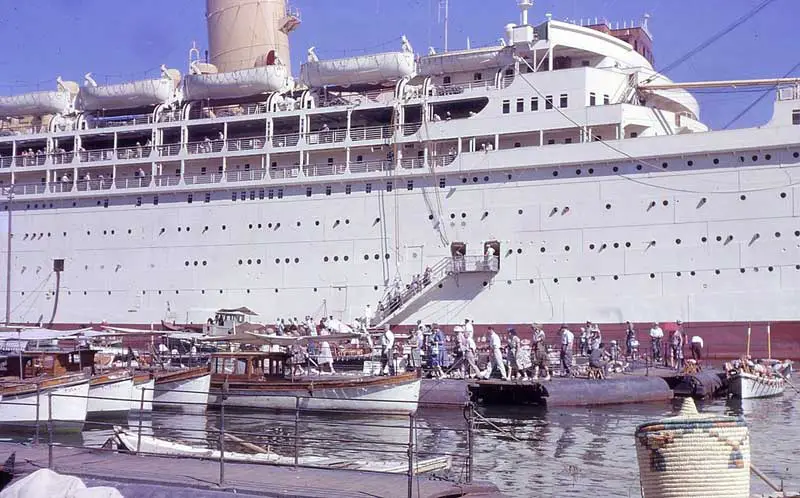
Strathmore was the third ‘Strath’ to be built. She was very similar in design to the earlier ‘Straths’. Of course, there were small differences in points of detail, some improvements having been made as a result of the earlier ships’ operations. Passenger accommodation, public rooms and amenities were substantially the same as on the Strathnaver and Strathaird. Barely a year old, Strathmore collided in the Thames estuary with a Norwegian vessel, the Baalbeck, in October 1956, but fortunately without injuries and only slight damage. In 1961 she was converted to ‘one class’ and was periodically used for cruising, including charter sailings for the Travel Savings Association, a fairly short-lived organisation. In October 1963 she was sold to the Greek ship-owner John S Latsis of Piracus, renamed Marianna Latsis and used for occasional pilgrim voyages, such as from West Africa and Libya to Jeddah and as a hotel ship at Jeddah. In 1966 she was renamed Henrietta Latsis and in 1967 was laid up in Elecius, Greece. She went to Italian ship breakers at La Spezia in May 1969. Incidentally the German U-Boat 562, which sank the Strathallan, used this port on a number of occasions.
Specifications
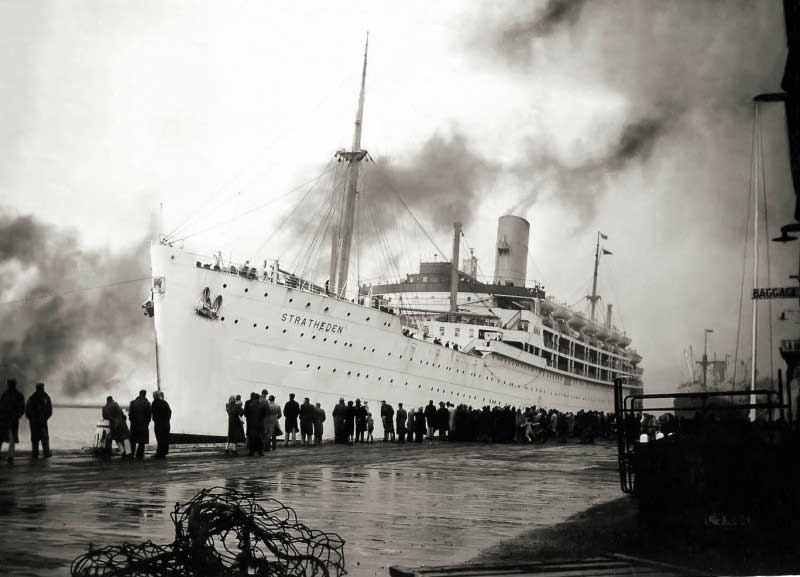
The fourth ‘Strath’ to be built, she was identical to the Strathmore except in a few small details. Less than two years after her launch, World War II broke out, and Stratheden was on her way to Australia, becoming the first British liner to pass through the Atlantic and Mediterranean submarine zones. During her wartime service as a troopship she carried 149,687 servicemen and civilians and steamed nearly 800,000 kms. Stratheden had the distinction of reopening the company’s Australian service after World War II. In 1950 Cunard chartered the vessel for four round trips between Southampton and New York. Five years later, during gales in the Ionian Sea, eight of the Stratheden’s crew were drowned while trying to rescue fishermen from a Greek trawler.
In 1961 she was converted to ‘one class’ and periodically chartered for cruising, including charter sailings for the Travel Savings Association, a fairly short-lived organisation. In October 1963 she was sold to the Greek ship-owner John S Latsis of Piracus , renamed Henrietta Latsis and used for occasional pilgrim voyages, such as from West Africa and Libya to Jeddah and as a hotel ship at Jeddah. In 1966 she was refitted and swapped names with the former Strathmore, and in 1967 was laid up in Elecius, Greece. She went to Italian breakers at La Spezia in May 1969. Incidentally the German U-Boat 562, which sank the Strathallan, used this port on a number of occasions.
Specifications
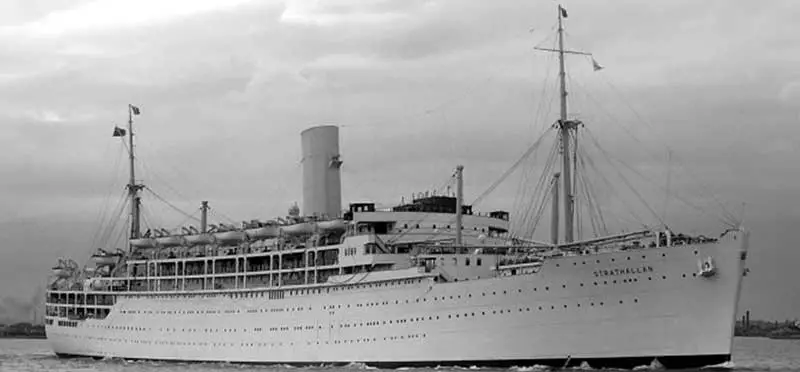
The last ‘Strath’ to be built, she also had the shortest life. Within 26 months of her maiden voyage to Australia, the British War Office seconded her as World War II troop carrier. Like all the ‘Straths’, she received her call-up orders on 4th February 1940. Strathallan was the only ‘Strath’ to not survive its period of military duty, being torpedoed and sunk by German U-Boat 562 in bright moonlight and fine weather shortly after passing through the Straits of Gibraltar about 75 kilometres (45 miles) off Bougie. She was hit in the engine room on the port side at 2.25 am on 21st December 1942. Two engineer officers and two Indian engine-room crew were killed in the explosion. The destroyer HMS Verity picked up the nurses and 1,000 troops on board and another destroyer, HMS Laforey, took Strathallan in tow. With the help of the salvage tug Restive it was hoped that she might reach Oran, but her list increased and the remainder of the troops were taken off by escorting destroyers. At 1.15 pm she caught fire, and once the fire reached her cargo of rockets and ammunition, the rest of the crew were taken off by Restive. She sank 19 km off Oran at 4 am, 22nd December 1942.
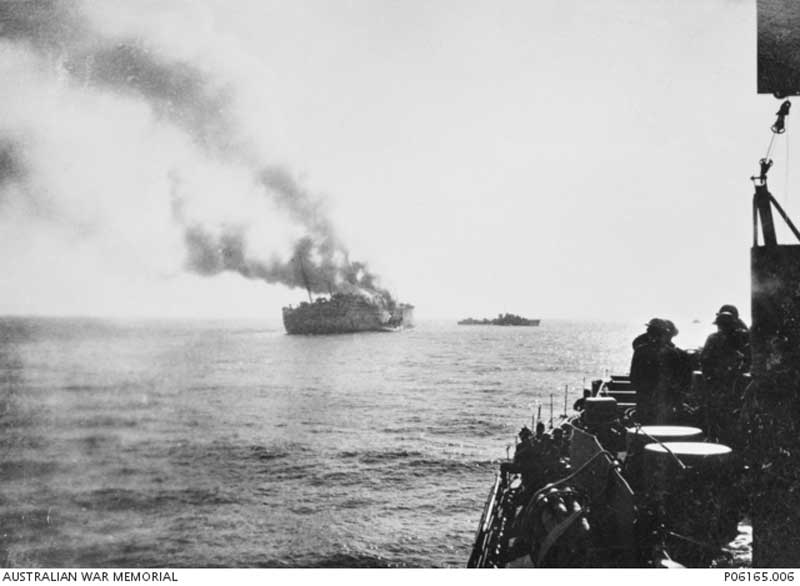
View from HMAS Quiberon towards the heavily damaged SS Strathallan before she sank. Photo: Australian war Memorial
Specifications
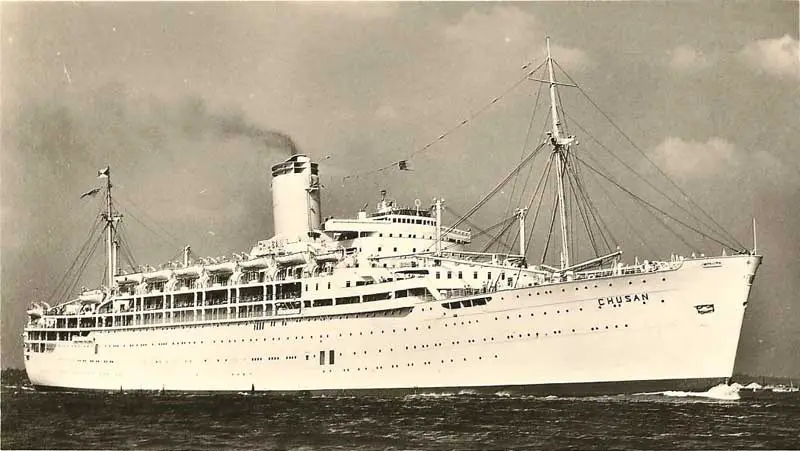
Ordered and designed before the war but built after it, Chusan was similar in appearance to Himalaya, especially with the distinctive funnel that both possessed, being a Thornycroft funnel top, fitted to keep smoke from blowing down onto the aft decks. Built for the London-Far East run via the Suezit was the first ship to re-establish a regular service between European and Japan after the war. In 1959 she was placed on an around-the-world service which included Bombay, Hong Kong and Yokohama. In 1963, Chusan served exclusively on the UK-Far East route until 1960, when she began calling at Australian & North American ports as well.
The ship played an important role in the famous London to Sydney Marathon, a car rally across the world which started from the Crystal Palace racing circuit in London at 2pm on Sunday, 24th November 1968 and ended at Warwick Farm (an outer Sydney suburb), on Tuesday, 17th December 1968. The cars drove from London to Paris, and then overland via Munich, Venice, Trieste, Belgrade, Istanbul, Teheran, Kabul to Bombay. The crews had a cut-off time by which they had to be at dockside to board the SS Chusan for Fremantle and only the leading 70 cars would be loaded. The cars were offloaded at Fremantle for the start of the last leg across Australia. The winner was Car 75, a Hillman Hunter driven by Scotsman Andrew Cowan.
P & O began winding up its Far Eastern service in 1970 with the transfer of the Chitral to the Eastern & Australian SS Co. The following year saw Chusan make her last call to Bombay. She was withdrawn from service in 1973 and arrived in Kaohsiung, Taiwan to be broken on 30th June 1973.
Specifications
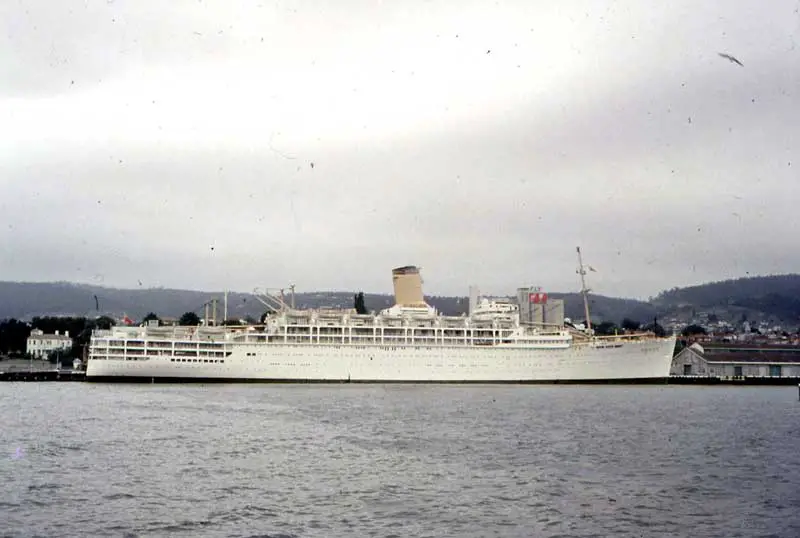
SS Himalaya in Hobart, December 1965
The first passenger liner designed and built by P&O; after World War II, Himalaya was similar in appearance to the company’s Far East Service liner Chusan. Built for London-Sydney run, Himalaya departed on her maiden voyage from Tilbury to Australia on 6th October, 1949, arriving in Melbourne on the 5th November. The service was soon extended beyond Sydney to San Francisco. In 1953, modifications were made to her funnel, adding a Thornycroft top to reduce soot from falling on the afterdeck. Himalaya had to be dry docked at Garden Island, Sydney in 1959 to repair propeller damaged in the Suez Canal. Though converted to a one-class ship with a capacity to carry 1,416 passengers in 1963, she began to make fewer and fewer line voyages and was used mainly for cruising. The increased cost of fuel caused by the oil crisis of the early 1970s combined with the fall off in trade led P&O; to retire her in 1974. On 28th November 1974 she arrived in Kaohsiung, Taiwan to be broken up.
Specifications
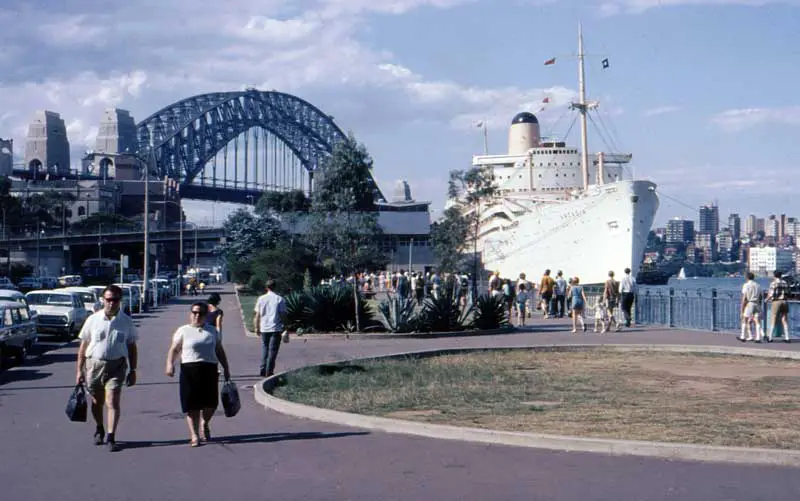
Arcadia has the distinction of being the largest P&O; liner to be built on the banks of the Clyde. Her design was in essence a larger and improved version of the post war designed Himalaya and Chusan. The Arcadia & Iberia were the last traditionally designed vessels built by P&O; and the largest passenger liners operating east of Suez. The Arcadia enjoyed a reliable career, however the Iberia was plagued with stability and mechanical problems. Arcadia was named after the 6,000 ton steamer of the same name, which entered P&O; service in 1888. The name is derived from a province in the Greek Peloponnese, the region of rural happiness in southern Greece.
Arcadia’s interior decor followed a conservative Greek theme prompted by her name was incorporated throughout her interior. The first-class dining room was named ‘Olympic’ and the tourist class, ‘Corinthian’. Other major public areas for example were named ‘Apollo’, ‘Orpheus’ and ‘Odyssey’. She had sixteen public rooms, nine of which were in the first class section. The floor covering of the Hookout Bar featured two map panels showing the eastern and Western hemispheres and figureheads stood on either side of the bar, copied from those of old wooden sailing ships. The centrepiece was in the form of a chart table fitted with a compass and chronometer, and flanked by terrestrial and celestial globes. The majority of the first class public rooms were on the promenade deck amidships and included the children’s nursery, the library and writing room, the first class lounge and ballroom, the verandah cafe and the swimming pool.
Like Himalaya, the Arcadia was constructed specifically for the London to Australia and New Zealand route, commencing service in February 1954. On her early voyages she used the same Suez-India route in both directions. In later years this was extended to include the Pacific and the American West Coast. Arcadia, like Himalaya and Chusan, had been built with dual-purpose line voyages and cruising in mind. It was in the latter role that Arcadia became one of the most popular ships ever to fly the P&O; flag. During the northern summers Arcadia’s voyages to the Pacific were interspersed by a series of cruises to the Canary Islands, North Africa and the Mediterranean. During the autumn she was repositioned to Sydney, from where she cruised the South Pacific Islands.
In April 1959, the whole ship was air-conditioned, the first class cabins were modernised and additional sundeck space was provided aft on her Promenade Deck. The overhaul was due to P&O;’s plan to raise her to the same standard as the new Canberra (at that time well under construction at Harland & Wolff’s Belfast yards). After its completion, she Arcadia returned to the Australian run, which she plied for the next ten years, interspersed with cruising from both Australia and Britain. Among the many British migrants who came to Australia on Arcadia was British Comedian Spike Milligan and his wife who arrived at Sydney on 4th July 1962. At that time, first class, “Boomerang” return passage trip cost £145.
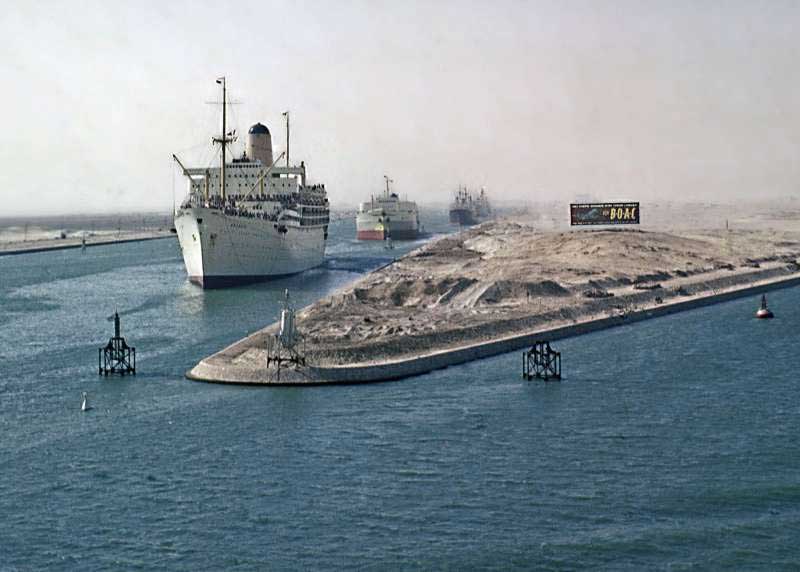
SS Arcadia leads a southbound convoy through the Suez Canal, August 1961
In 1970, Arcadia was to transferred to San Francisco, from where she cruised to Mexican ports. These proved very successful and she remained there for several years. After Himalaya was withdrawn from Australia, Arcadia was transferred back to Sydney. She was based there for the next three years, cruising to Asian and Pacific ports. In the spring of 1976 she made a few cruises from Southampton and was then permanently based at Sydney as a Pacific and Orient cruise ship, the last of the ‘old-style’ P&O; liners to serve Australia. A regular annual cruise ex-Sydney took her to Hong Kong, where she entered dry dock for a full inspection and overhaul. Apart from the yearly arrival of Canberra in the course of her round-world cruise, and the Oriana’s season of summer cruises from Sydney, Arcadia was now the sole representative of the P&O; fleet in the South Pacific.
In September 1978, the Swedish vessel Kungsholm was purchased as a replacement for her in the Pacific cruise trade. It was initially announced that the newer ship would operate alongside Arcadia, but this was not to be. After the announcement of her retirement, many thousands gathered at vantage points along the harbour’s edge to wave her a last goodbye. During her twenty five-year career she had steamed, 2,650,000 miles and carried 430,000 passengers. In February 1979, she was sold to the Nisshoi-Iwai Company of Tokyo, being the last of the post World War II P&O; liners to be scrapped. She was purchased at the market rate of $100 per light displacement ton (she was 23,060 light displacement tons). Her complete dismantling took ten weeks.
Specifications
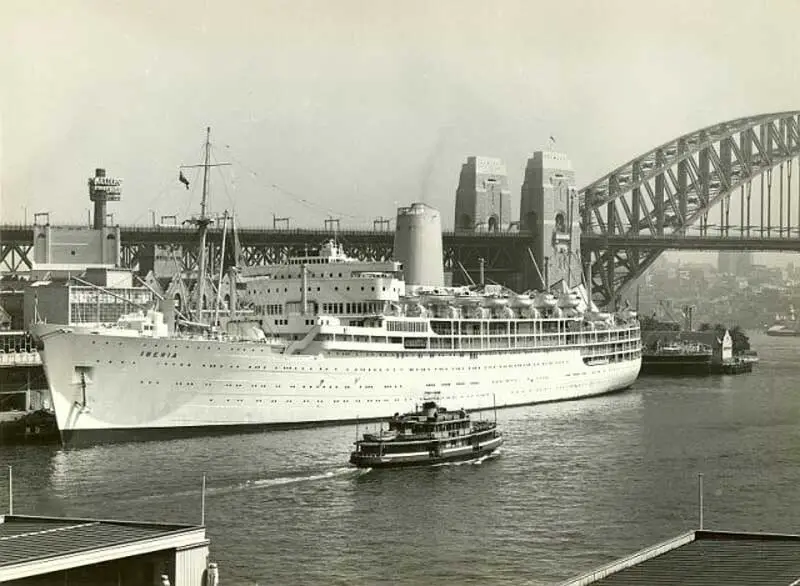
Iberia was the last of the trio of ships ordered by P&O; in the post war euphoria. The three ships were almost identical in size and design, being based on the Chusan but with more modern features. They had to be built in different shipyards around the United Kingdom in order to be delivered on time. Ibera was built in Belfast, Ireland, in the same shipyard as Britannic, Olympic and its famous sister, RMS Titanic as well as SS Canberra some years later.
Iberia is named after the peninsular on which Spain and Portugal are found, which is the ‘Peninsular’ referred to in the name of the shipping line, Peninsular and Oriental Steam Navigation Company. Throughout her life, Iberia was plagued with stability and mechanical problems and though well equipped and well liked by passengers, she never really found her niche. The management at P&O; did not accurately forecast the degree of downturn that the popularity of air travel in the 1960s would bring to their business. Had they done this, they may well have reduced the number of ships they built in the 1950s to two and not commissioned the Iberia, as, from the day she was brought into service, she was always somewhat superfluous. Even in the 1970s when many ships were being retired and Iberia still had plenty of life left in her, the role of a key southern Pacific cruise liner to which she had played bridesmaid for so long was taken by the newer, more modern Oriana.
Iberia was placed on the trans Pacific service in 1959, but 2 years later, had to be deployed on part time cruising duties out of Sydney because of a fall off in trans Pacific trade subsequent to the introduction of Boeing 707 aircraft on trans Pacific air routes. In 1972 Iberia was transferred to full time cruising out of Sydney. As Himalaya, Iberia and Arcadia were all sharing this business, there was not enough to go around and Iberia and Himalaya were withdrawn and sold off for scrap, leaving the Arcadia and later the Oriana to service the South Pacific cruise market. She arrived in Kaohsiung, Taiwan to be broken on 5th September 1972.
Specifications
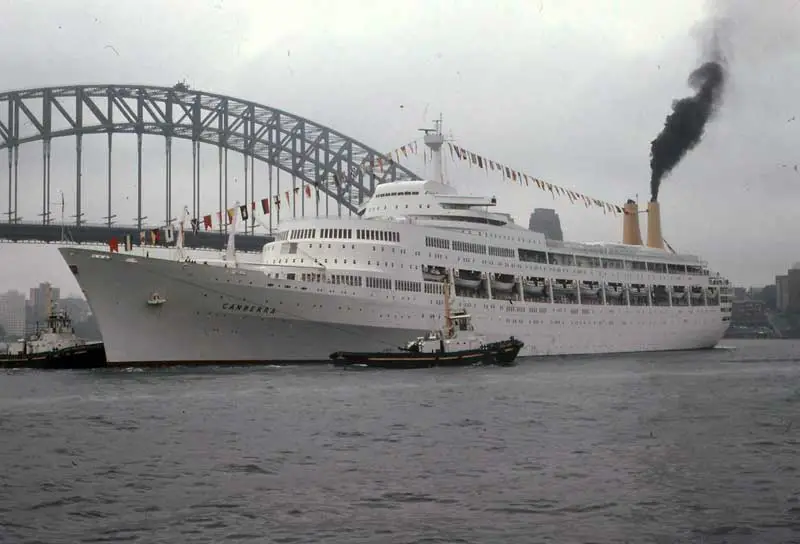
As the shipping industry braced itself for a downturn in passenger business after World War II upon the introduction of economical air travel, the P&O; shipping line showed its dogged optimism by ordering a new superliner to fill the gap that would be left when its aging “Strath” liners were retired. Harland & Wolff, the Belfast-based firm who had built the Titanic, Britannic and Olympic for White Star and their own Iberia a few years previous, won the contract in December 1956. The new 45,000 tonne ship would follow a radical design introduced by the Southern Cross, which placed the propulsion machinery aft, leaving the bulk of the ship for passenger accommodation. On 23rd September 1957, on Slipway 14, Queens Island, Belfast, the first keel plates of Yard Number 1621 were laid. Six months later it was revealed its name would be Canberra, an aboriginal word meaning, “meeting place by the water” which was also the name of Australia’s new capital city. The name was appropriate given this new ship was being purposely build to service the UK – Australia migrant run.
Dame Pattie Menzies, wife of the Australian Prime Minister, launched Canberra on 16th March 1960. She began her working life travelling between Southampton and Australia in June 1961, but as global transportation and travel habits evolved, so did Canberra. In the early 1970’s she was almost scrapped as the need for passenger liners diminished – with air travel and oil prices on the increase. A last minute reprieve saw Canberra transferred to the growing Mediterranean and Caribbean cruising markets in 1975, and she never looked back. In 1982 Canberra was commandeered by the British Navy to carry British troops into the war zone of the Falkland Islands, its sports deck was converted to a helicopter-landing pad. After the conflict, Canberra returned home to a fantastic welcome in Southampton. She served many more years cruising, though not in Australian waters, before being retired in 1997.
She left Southampton for the very last time on Friday 10th October 1997. Three days later en route to the ship breakers at Pakistan who paid $5,640,818 for her, Canberra passed Oriana bound for Vigo, and on 29th October reached Gadani Beach. Steaming at almost full speed – accompanied by the bagpipes being played full volume over the open deck circuits – Canberra was beached and the dismantlers climbed aboard. The dismantling job, which was expected to take just three months, took well over a year, and it is believed that the yard lost a great deal of money trying to scrap her just as Harland & Wolff had lost money building her.
Specifications








